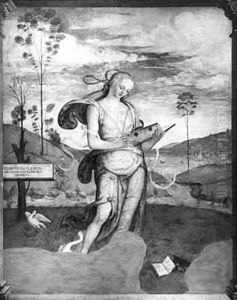Pietro (Lo Spagna) Giovanni di Paintings
Pietro Giovanni di Bartolomeo, known as Lo Spagna ('the Spaniard'), was a prominent Italian painter of the Renaissance, active mainly in Umbria. His nickname, Lo Spagna, suggests Spanish origins, but much about his early life, including his exact birthplace and date, remains a matter of speculation among art historians. He is believed to have been born around 1450, and his artistic career flourished in the late 15th and early 16th centuries. Lo Spagna is noted for his close association with the Umbrian school of painting, which was deeply influenced by the works of Perugino and the young Raphael.
Lo Spagna's work is characterized by its delicate use of color, graceful figures, and serene landscapes, reflecting the harmonious ideals of the High Renaissance. Although he was profoundly influenced by his contemporaries, Lo Spagna's art carries a personal stamp that distinguishes his work, particularly in the way he composed his religious scenes and landscapes with a gentle, lyrical quality. He was adept at fresco painting as well as panel painting, contributing significantly to the decoration of churches and public buildings in and around Spoleto, Terni, and other towns in Umbria.
Among his most notable works are the frescoes in the Church of San Francesco in Todi and the apsidal decoration of the Church of San Giovanni Battista in Spoleto, which showcase his mastery of color and composition. His altarpieces, characterized by their serene beauty and refined use of light, were highly sought after and remain key examples of Umbrian Renaissance art.
Lo Spagna's influence extended beyond his immediate geographical area, contributing to the spread of the Renaissance ideals throughout Central Italy. Despite his Spanish nickname, his work is quintessentially Italian, synthesizing the influences of his teachers and contemporaries with his unique sensibility. Lo Spagna died in 1528, leaving behind a body of work that continues to be admired for its gracefulness and tranquility. His legacy is that of an artist who managed to capture the spiritual and aesthetic aspirations of his time, making a significant contribution to the Italian Renaissance.
